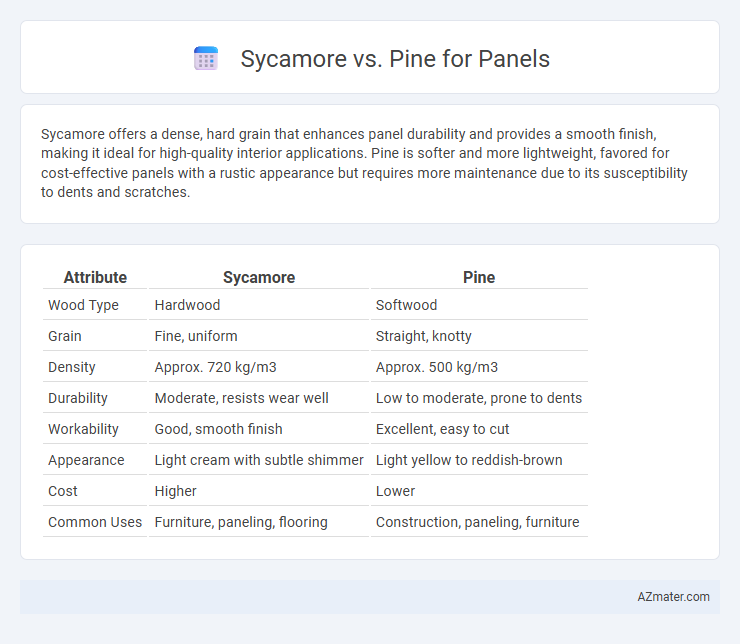Sycamore offers a dense, hard grain that enhances panel durability and provides a smooth finish, making it ideal for high-quality interior applications. Pine is softer and more lightweight, favored for cost-effective panels with a rustic appearance but requires more maintenance due to its susceptibility to dents and scratches.
Table of Comparison
| Attribute | Sycamore | Pine |
|---|---|---|
| Wood Type | Hardwood | Softwood |
| Grain | Fine, uniform | Straight, knotty |
| Density | Approx. 720 kg/m3 | Approx. 500 kg/m3 |
| Durability | Moderate, resists wear well | Low to moderate, prone to dents |
| Workability | Good, smooth finish | Excellent, easy to cut |
| Appearance | Light cream with subtle shimmer | Light yellow to reddish-brown |
| Cost | Higher | Lower |
| Common Uses | Furniture, paneling, flooring | Construction, paneling, furniture |
Introduction to Sycamore and Pine Wood
Sycamore wood features a consistent, fine grain with a light, creamy color that makes it ideal for smooth, detailed paneling and furniture surfaces. Pine wood, known for its soft texture and warm, yellowish tone, is lightweight and easy to work with, making it a popular choice for rustic or casual panel applications. Both woods offer distinct aesthetic and functional qualities, with sycamore providing durability and fine detail, while pine allows affordability and ease of customization.
Botanical Overview: Sycamore vs Pine
Sycamore (Platanus genus) is a deciduous hardwood tree characterized by broad, lobed leaves, exfoliating bark, and a fast growth rate, commonly used for furniture and paneling due to its fine grain and durability. Pine (Pinus genus) is an evergreen softwood tree with needle-like leaves, resinous sap, and a straight grain, valued for its lightweight properties and ease of machining in panel applications. The botanical differences between sycamore and pine influence panel performance, with sycamore offering greater hardness and aesthetic appeal, while pine provides cost-effective strength and versatility.
Appearance and Grain Patterns
Sycamore panels showcase a distinctive, wavy grain pattern with a creamy to light brown hue, offering a unique and eye-catching appearance perfect for decorative applications. Pine panels feature a more uniform grain with prominent knots and a pale yellow to light brown color, providing a rustic and warm aesthetic. The choice between Sycamore and Pine for panels depends on desired visual impact--Sycamore emphasizes intricate, flowing grains while Pine highlights natural, rustic charm.
Durability and Hardness Comparison
Sycamore wood exhibits moderate hardness, rating around 1,350 on the Janka scale, offering good durability for interior paneling but is more prone to denting compared to pine. Pine, particularly Southern Yellow Pine, presents a higher Janka hardness of approximately 1,220 to 1,300, making it slightly softer but more resilient to wear and impact in panel applications. Both woods provide reliable durability, though sycamore's fine grain and hardness contribute to a smoother finish, while pine offers greater resistance to compression and deformation over time.
Workability and Machining Characteristics
Sycamore wood offers excellent workability due to its fine, even texture and uniform grain, making it ideal for precise machining and detailed panel work. Pine, being softer and more resinous, machines easily but may produce rougher edges and is prone to tear-out during intricate cutting processes. Both woods respond well to common woodworking tools, but sycamore's stability and smooth finish provide superior results for panels requiring fine detail and a polished appearance.
Finishing and Staining Properties
Sycamore offers a smooth, tight grain ideal for an even finish and excellent stain absorption, resulting in rich, consistent colors. Pine, with its prominent knots and softer texture, can absorb stains unevenly, often requiring a conditioner for a uniform appearance. Choosing sycamore for panels ensures a refined, high-quality finish, while pine provides a rustic look with more variation in staining.
Cost and Availability
Sycamore panels typically cost more due to their finer grain and limited supply compared to pine, which is widely available and budget-friendly. Pine is often favored for large-scale projects because of its abundant availability and lower price point, making it ideal for cost-conscious applications. Sycamore's higher cost is justified by its durability and aesthetic appeal, but availability can be limited in some regions, impacting lead times.
Environmental Impact and Sustainability
Sycamore wood for panels offers a more sustainable option due to its faster growth rate and improved carbon sequestration compared to pine, which often involves slower-growing species with higher ecological footprints. Pine panels, while popular for their strength and availability, typically require more intensive forestry practices that can contribute to deforestation and habitat disruption if not sourced responsibly. Choosing FSC-certified sycamore panels reduces the environmental impact through responsible harvesting and promotes sustainable forest management, aligning with eco-friendly building standards.
Common Uses in Paneling
Sycamore panels are commonly used in interior wall paneling and decorative veneers due to their fine, even texture and light, creamy color that enhances modern and traditional aesthetics. Pine panels are widely favored for rustic and farmhouse-style interiors because of their distinct knots, warm tones, and affordability, making them suitable for ceilings, walls, and wainscoting. Both woods offer versatility, with sycamore providing a smooth finish ideal for painted surfaces and pine offering a natural, textured look that accepts stains well.
Choosing Between Sycamore and Pine for Panels
Choosing between sycamore and pine for panels depends on factors like durability, grain pattern, and project aesthetics. Sycamore offers a fine, uniform grain with a smooth finish ideal for high-end furniture and decorative panels, while pine provides a more rustic appearance with visible knots and a softer texture better suited for casual or economical applications. Consider sycamore for stability and elegance and pine for affordability and ease of workability in panel construction.

Infographic: Sycamore vs Pine for Panel
 azmater.com
azmater.com